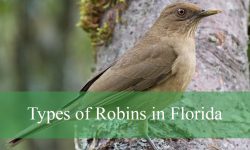Doves and pigeons in Alabama are a diverse and captivating part of the state’s birdlife. From the soft coos of the Mourning Dove to the striking appearance of the White-winged Dove, these birds enrich Alabama’s natural environments. Exploring doves and pigeons in Alabama reveals a variety of species adapted to different habitats, from forests to urban areas.
The landscapes across Alabama, including woodlands, open fields, and suburban neighborhoods, provide perfect homes for many types of doves and pigeons. Their presence is noticeable almost everywhere, making doves and pigeons in Alabama some of the most common birds that birdwatchers and nature lovers can enjoy year-round.
Learning to identify the different species of doves and pigeons in Alabama adds excitement to birdwatching and helps deepen understanding of their behaviors and roles in the ecosystem. This article introduces nine key species with pictures and detailed descriptions to help you recognize and appreciate these beautiful birds.
Common Doves and Pigeons in Alabama
Mourning Dove (Zenaida macroura)

The Mourning Dove is one of the most widespread and familiar doves in Alabama, easily recognized by its slender, streamlined body and long, pointed tail. Adults typically measure about 9 to 13 inches in length, with a wingspan ranging from 17 to 18 inches. Their plumage is a soft grayish-brown with subtle pinkish hues on the breast and characteristic black spots on the wings. The tail feathers have white edges, especially visible in flight, contributing to their graceful appearance.
Identification is straightforward due to their distinct morphology and gentle coloration. Mourning Doves have a small head relative to their body size and a delicate black beak. Their eyes are large and dark, encircled by a subtle blue skin ring. The black spots on their wings and their long tail, which often has white tips, help distinguish them from other dove species in the region. Juveniles tend to be duller in color with less pronounced spotting.
The Mourning Dove’s mournful, soft cooing call is one of its most recognizable features. The call is a low, drawn-out “coo-ah, coo, coo, coo” sound that can often be heard in the early morning or late afternoon. Behaviorally, these doves are graceful flyers, capable of rapid, direct flight with quick wing beats. They feed primarily on seeds found on the ground, often visiting bird feeders and open fields. Mourning Doves usually form small flocks but pair off during breeding seasons to build flimsy nests on tree branches, shrubs, or man-made structures.
In Alabama, Mourning Doves are highly adaptable, inhabiting a range of environments from open fields, farmland, and grassy clearings to suburban yards and woodland edges. They are commonly seen throughout the state year-round, taking advantage of the warm climate. Their adaptability to different habitats and food sources has helped maintain robust populations, making them one of the most abundant bird species in Alabama.
White-winged Dove (Zenaida asiatica)
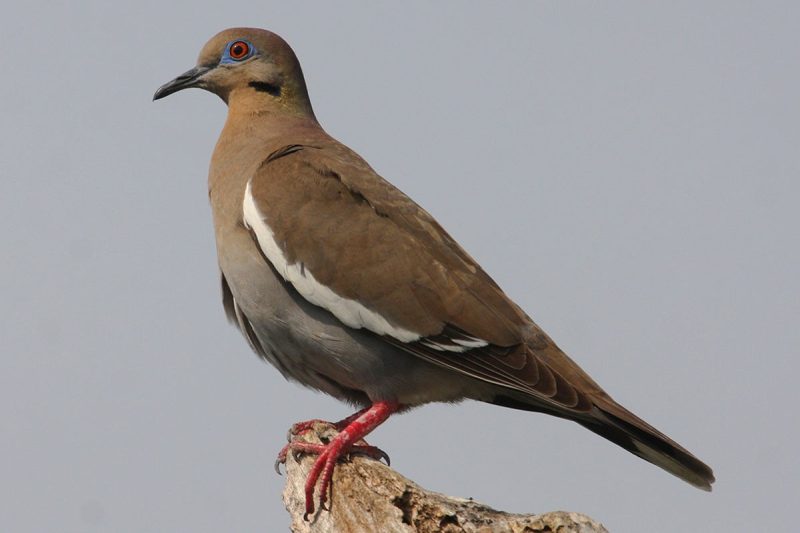
The White-winged Dove is larger and more robust compared to the Mourning Dove, measuring around 11 to 13 inches in length with a wingspan of approximately 18 to 22 inches. It features a grayish-brown body with a distinctive white stripe along the edge of its wings, which is most visible during flight. Its overall coloration is more muted than the Mourning Dove, with less pink on the breast and more uniform brown tones.
Identification of the White-winged Dove is marked by the prominent white wing stripe and a dark line running beneath its eyes. Its head and neck are more rounded, and the bill is slightly thicker. The white wing patches are a key field mark, especially noticeable when the bird takes flight or displays its wings. Its tail is squared off with white tips on the outer feathers. The eyes are deep red, adding a striking feature to its face.
The vocalizations of the White-winged Dove differ from the Mourning Dove’s mournful coos. Its call is a repetitive “whoo-whoo-whoo” or “coo-coo-coo” that is often louder and more rhythmic. Behaviorally, this species is more gregarious, frequently seen in small flocks. It feeds mainly on seeds and fruits and can often be spotted foraging on the ground or visiting fruiting trees and feeders. The White-winged Dove builds nests in dense shrubs or trees, favoring areas that provide good cover.
In Alabama, the White-winged Dove is more commonly found in the southern regions, where the climate and habitat better suit its preferences. It frequents woodlands, scrublands, and increasingly suburban and urban areas as its range expands northward. This northward expansion is part of a larger trend observed over the last several decades, likely due to changing climate conditions and habitat availability, making it a species of growing interest in Alabama birding circles.
Eurasian Collared-Dove (Streptopelia decaocto)
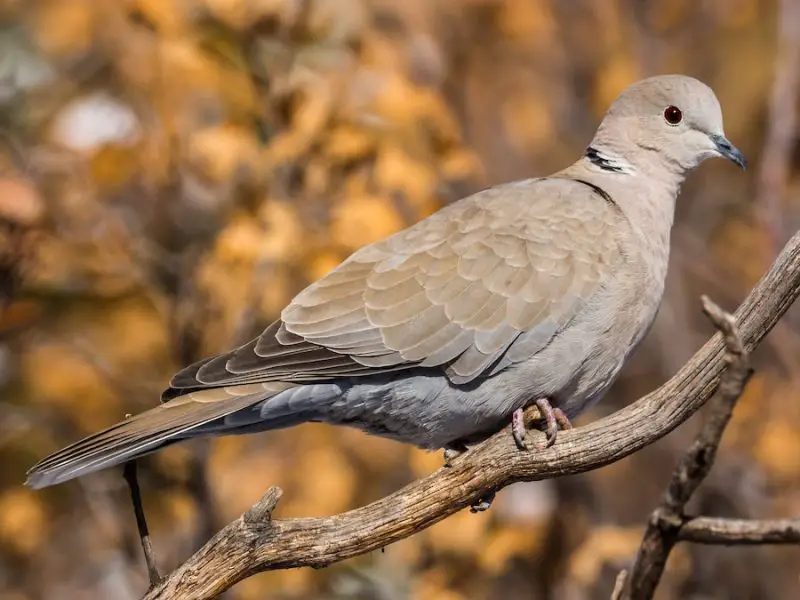
The Eurasian Collared-Dove is a medium-sized dove, measuring about 11 to 12 inches in length with a wingspan close to 18 inches. It is easily recognized by its pale gray body and the distinctive black collar marking on the back of its neck, which sharply contrasts against its otherwise light plumage. The feathers are generally uniform light gray with slightly darker tail tips. Its body is plumper than native doves, giving it a robust and compact appearance.
Identification features include the lack of wing spots seen in Mourning Doves and the absence of the white wing patch found on White-winged Doves. The black collar around the neck is the species’ most notable characteristic. It has a relatively small head, dark eyes, and a light pinkish beak and legs. The tail is squared with a white edge, visible during flight. Its smooth, cooing call is a series of repetitive “coo-coo-coo” notes, distinct from native species.
Behaviorally, Eurasian Collared-Doves are highly adaptable and aggressive, often competing with native doves for food and nesting sites. They are mostly sedentary but have rapidly expanded their range since their introduction to North America in the 1980s. Their flight is swift with steady wing beats. They feed on seeds and grains, often frequenting bird feeders and open grounds. These doves nest on ledges, trees, and building structures, often forming loose colonies.
In Alabama, the Eurasian Collared-Dove has spread widely, thriving in suburban, rural, and agricultural areas. Its presence is noted throughout the state, with higher densities near human settlements. The species has adapted well to Alabama’s environment, and its rapid expansion has made it one of the most commonly seen doves in urban landscapes. Its spread represents an important ecological shift within the dove communities in the region.
Rock Pigeon (Columba livia)
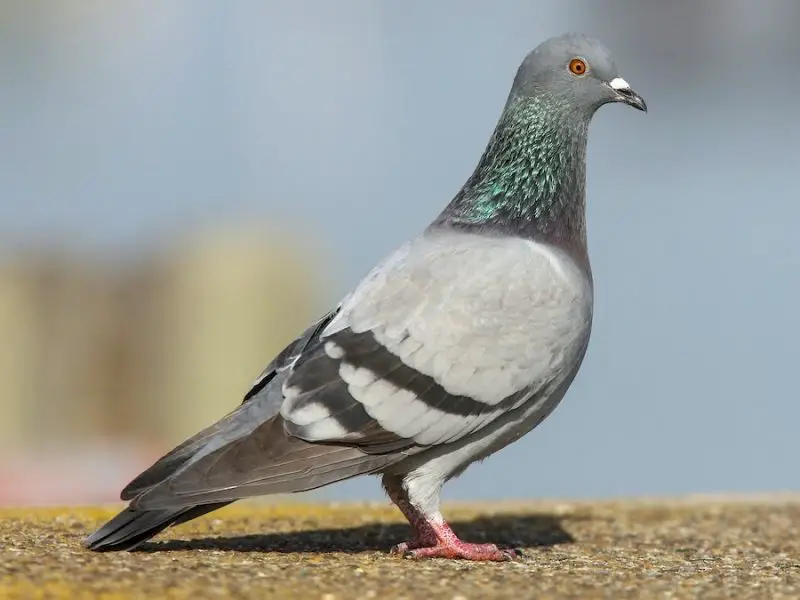
The Rock Pigeon, often called the city pigeon, is highly variable in coloration but typically sports a gray body with iridescent feathers on the neck that shimmer in green and purple hues. Its size ranges from 11 to 14 inches long, with a wingspan between 23 and 28 inches, making it one of the larger dove species in Alabama. It has a stout body, short legs, and a rounded head, adapted for living in urban environments.
Identification is aided by its range of color morphs, which can vary from light gray to almost entirely black or white. The iridescent neck feathers and two dark wing bars are characteristic features. The Rock Pigeon’s eyes are usually orange or red, and it has a distinctive white cere above the bill. Its flight is direct and fast, often characterized by strong wing beats and occasional glides. The typical call is a loud, rhythmic “coo-coo” sound that resonates well in cities.
Rock Pigeons are highly social and often seen in large flocks around cities, parks, and farms. They feed on grains, seeds, and human food scraps, frequently scavenging in urban areas. Their nesting sites include ledges of buildings, bridges, and other man-made structures that mimic their natural cliff-side habitats. They are territorial during breeding but otherwise peaceful and tolerant of large groups.
In Alabama, Rock Pigeons are ubiquitous in urban centers such as Birmingham, Mobile, and Huntsville, thriving alongside humans. They are year-round residents, well adapted to Alabama’s climate and landscape. Their populations are stable due to their flexible diet and nesting habits, making them a prominent and well-known bird species in the state’s towns and cities.
Inca Dove (Columbina inca)
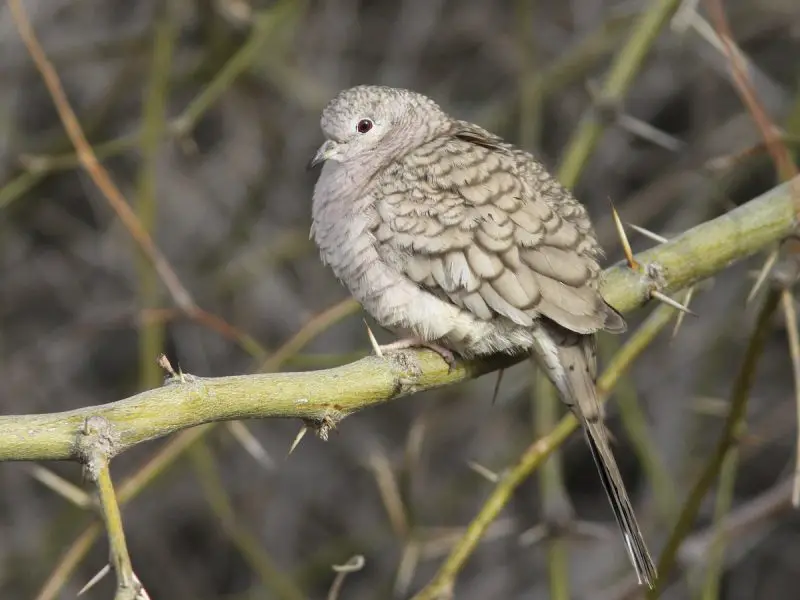
The Inca Dove is a small, slender bird measuring about 8 to 9 inches in length, making it one of the smaller doves in Alabama. It is notable for its scaled feather pattern on the back and wings, created by fine black and buff edging that gives a delicate mosaic effect. Its coloration is generally a soft brownish-gray, blending well with dry brush and open woodland floors.
Identification involves observing the scaled pattern on the wings and back, which is unique among the local dove species. It has a relatively long tail for its size, often showing white edges on the outer feathers. The head is small with a slender bill, and its eyes are dark with a faint blue skin ring. The Inca Dove’s call is a soft, rapid series of cooing notes, often described as “coo-coo-coo,” but softer and more subtle than other doves.
Behaviorally, the Inca Dove is shy and elusive compared to other doves, preferring to walk on the ground in search of seeds and small insects. It often forages in dry, open brushy areas and is less likely to visit bird feeders. During breeding, it constructs small, fragile nests low in shrubs or trees. They tend to form small groups or pairs rather than large flocks.
In Alabama, the Inca Dove is primarily found in the southern parts of the state, where the climate and habitat resemble its preferred arid and semi-arid environments. It inhabits dry brushy areas, open woodlands, and urban gardens, often blending into the surrounding vegetation. Its distribution in Alabama is somewhat limited but stable, making it a less commonly seen but interesting species for bird watchers in the region.
Common Ground-Dove (Columbina passerina)
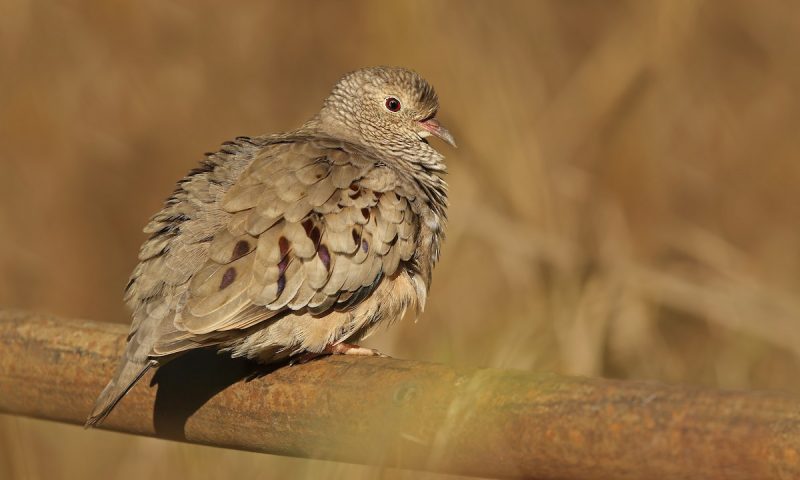
The Common Ground-Dove is among the smallest doves in Alabama, measuring just about 6 to 7 inches in length with a wingspan of approximately 10 to 12 inches. Its petite size and delicate build make it easily distinguishable from larger doves. The plumage is a soft grayish-brown with a subtle scaly or mosaic pattern on its breast, created by fine, dark-edged feathers. The overall coloration helps it blend seamlessly into the dry leaf litter and scrubby environments where it is often found.
Identification of the Common Ground-Dove relies heavily on its small size and the distinctive scaled pattern on the breast and sides. The head is rounded with a short, slender bill, and the eyes are dark with a faint blue ring around them. Its tail is relatively short and squared, often showing white tips on the outer feathers. In flight, its wingbeats are quick but gentle. The bird’s soft, rapid cooing call sounds like a faint “whoo-whoo” or “croo-croo,” often difficult to hear unless nearby.
Behaviorally, the Common Ground-Dove spends much of its time on the ground, foraging for seeds and small insects among low vegetation and leaf litter. It is a shy and secretive species, often running or fluttering short distances rather than flying long distances when disturbed. These doves usually form small groups or pairs. During the breeding season, they build small, fragile nests low in shrubs or dense brush, sometimes using abandoned nests from other birds.
In Alabama, the Common Ground-Dove inhabits open woodlands, scrublands, thorny thickets, and areas with dense low vegetation, especially in the southern and coastal parts of the state. It favors dry habitats and is less common in heavily forested or urban areas. While not as widespread as some other doves, it maintains stable populations where suitable habitat exists, making it a rewarding species for birders interested in more elusive ground-dwelling doves.
Band-tailed Pigeon (Patagioenas fasciata)

The Band-tailed Pigeon is one of the larger pigeon species found in Alabama, measuring about 12 to 15 inches in length with a wingspan that can reach up to 24 inches. It has a robust body, long wings, and a distinctive long tail edged with pale gray or white. One of its most defining features is the broad white or light-colored band across the back of its neck, which stands out against its otherwise dark gray or slate-colored body.
Identification is relatively straightforward thanks to its size and the contrasting neck band. The bird’s plumage is mostly smooth and slate-gray, with iridescent green or purple highlights on the neck and upper breast, which can shimmer in sunlight. Its head is rounded, and the eyes are bright yellow or orange, framed by a thin white eye ring. The Band-tailed Pigeon’s flight is powerful and direct, characterized by slow, deep wing beats.
The call of the Band-tailed Pigeon is a low, resonant “whoo-oo” or “coo” repeated in a steady rhythm. These pigeons tend to be shy and elusive, often staying high in the forest canopy. They feed mainly on seeds, berries, and fruits, frequently visiting oak and pine forests in search of mast and acorns. Their behavior includes strong flocking outside the breeding season but becoming more solitary or paired when nesting.
In Alabama, the Band-tailed Pigeon is primarily found in forested habitats, especially in higher elevations and mountainous areas such as the Appalachian foothills in the northeastern part of the state. It favors mature hardwood and mixed pine forests where food is abundant. Although not as common as more urban-adapted pigeons, its presence is a sign of healthy, undisturbed forest ecosystems, and sightings are prized by bird enthusiasts in Alabama.
White-crowned Pigeon (Patagioenas leucocephala)
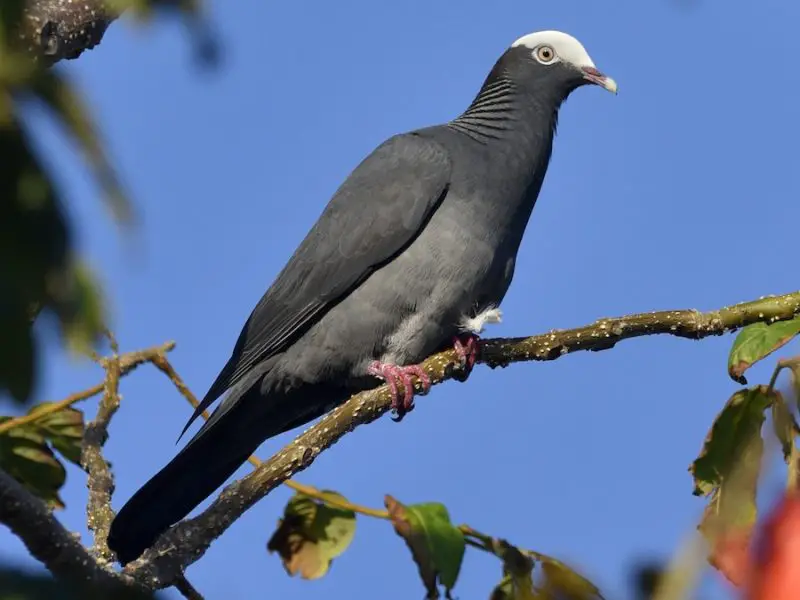
The White-crowned Pigeon is a rare and specialized species in Alabama, mostly confined to coastal and subtropical environments. It measures about 12 to 14 inches in length, with a relatively large wingspan for its size. Its most striking feature is the bright white crown on its head, which sharply contrasts with the rest of its dark gray to nearly black body plumage. The bird has a sleek, streamlined shape with broad wings adapted for strong flight.
Identification is dominated by the brilliant white patch covering the entire crown and extending down the back of the neck. The rest of the plumage is deep slate-gray or charcoal, often with a slight purplish or greenish iridescence on the neck and breast. Its eyes are dark red, giving the bird a striking gaze. The White-crowned Pigeon’s call is a low, throaty “coo-oo” or “coo-ah,” which echoes softly in the coastal forests.
This species prefers habitats such as mangrove swamps, hardwood forests, and coastal hardwood hammocks where it feeds primarily on fruits, berries, and seeds. Its behavior includes strong flight capabilities, often traveling between feeding and roosting sites over long distances. The White-crowned Pigeon tends to nest in dense foliage, building sturdy twig nests high in trees to avoid predators.
In Alabama, the White-crowned Pigeon is rarely encountered and is mostly found in the southernmost coastal counties near the Gulf of Mexico. Its presence is closely tied to subtropical habitats, which are limited in the state. Conservation of coastal forests and mangrove habitats is essential for the survival of this species in Alabama. Birdwatchers cherish sightings of this elegant and uncommon pigeon due to its rarity and distinctive appearance.
White-tipped Dove (Leptotila verreauxi)

The White-tipped Dove is a medium-sized dove, measuring approximately 11 to 13 inches in length, with a wingspan of around 18 to 20 inches. It has a sturdy body with soft, mostly brownish-gray plumage and distinctive white tips on its tail feathers, which give the species its name. The overall coloration is muted, with subtle variations of gray and brown that provide excellent camouflage in dense vegetation and forested habitats.
Identification of the White-tipped Dove includes its relatively large size compared to some smaller doves, a pale face with a faint blue-gray patch around the eye, and the white-tipped tail feathers that are visible during flight or when the tail is fanned. Its bill is medium-length and slightly curved, while the legs and feet are pinkish. The dove’s call is a low, rhythmic “hoo-hoo-hoo” or a soft “coo-coo,” often given in a series during the early morning or late evening.
Behaviorally, the White-tipped Dove prefers dense tropical and subtropical woodlands, thickets, and forest edges. It feeds mostly on seeds, fruits, and small insects found on the ground or low vegetation. It is generally shy and secretive, often remaining hidden in thick cover and rarely venturing into open spaces. Breeding involves building a simple nest of twigs low in bushes or trees, where the female lays two white eggs.
In Alabama, the White-tipped Dove is an extremely rare visitor, considered a very uncommon vagrant or accidental species. While it is common and widespread in southern Texas, Mexico, and Central America, its occurrence in Alabama is sporadic and not well documented. Any sightings of this species in Alabama are regarded as noteworthy by birders, likely representing stray individuals blown off course or rare wanderers far outside their typical range.
Best Time and Places to See Doves and Pigeons in Alabama
The best time to observe doves and pigeons in Alabama is during the warmer months, particularly from late spring through early fall. During this period, many species are actively breeding, foraging, and calling, making them more visible and easier to hear. Mourning Doves and Eurasian Collared-Doves are especially active during the early morning and late afternoon hours, when they feed and perch in open areas. While some species, like the Rock Pigeon and Mourning Dove, are year-round residents, others such as the White-winged Dove and Inca Dove may be more frequently seen in summer.
Ideal places to see doves and pigeons in Alabama include open fields, farmland, woodland edges, and suburban areas with scattered trees and shrubs. Public parks, rural roadsides, and agricultural fields often attract Mourning Doves and Eurasian Collared-Doves. Urban areas such as downtown Birmingham, Mobile, or Montgomery are excellent for spotting Rock Pigeons, especially near buildings, bridges, and open plazas. Bird feeders in backyards across the state can also attract several species, especially in more open residential neighborhoods.
For birdwatchers looking for less common species, the southern regions of Alabama offer the best chance. Places like the Gulf Coast, the Mobile-Tensaw Delta, and surrounding scrublands may provide rare sightings of White-winged Doves, Inca Doves, or even occasional vagrants like the White-crowned Pigeon. Quiet trails and wildlife management areas near the coast or in dry brushy habitats are ideal for spotting these rarer doves, especially during migration or warm seasons.
To increase the chances of successful sightings, bring binoculars and visit during calm weather conditions when birds are more likely to be active. Early morning is often the most productive time, as doves and pigeons come out to feed. Staying quiet and watching areas with open ground, low vegetation, or water sources can lead to excellent views of doves and pigeons in Alabama’s varied landscapes.


